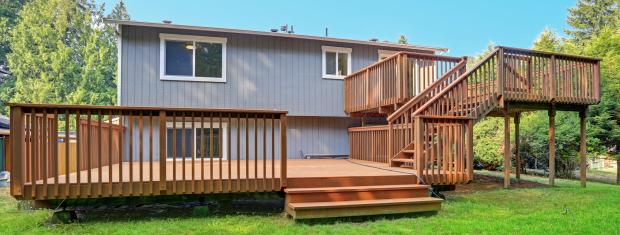
3 Tell Tale Signs Your Deck is Becoming a Hazard
Your deck is your haven. Whether used for entertaining friends or making memories with the kids, it’s a part of your home you’ve learned to love.
The average life expectancy of a wooden deck is 10 to 15 years, but if it is properly maintained and sealed you could make it last upwards of 20 years. Considering when your deck was built, and how long it’s been used, do you still believe it is safe?
After so long that place you’ve shared so many happy memories could create, not so happy memories. Once you hear yourself telling your son Joey not to hold onto the railing, it’s probably time to consider renovating or replacing your deck.
We’ve put together some signs to look for when your deck is probably turning into a hazard to your friends and family:
1. Wood Rot & Warping
If your deck begins to crack, split or fray, chances are it has endured some sort of water damage. Boards that once were straight now have a noticeable sway or curve to them, this is warping. Either way, the wood has started to deteriorate and its structural integrity has been compromised and needs to be replaced.
2. Loose Connections
Wobbling Deck Boards
Wobbling and loud creaking are early signs that your deck has a failing structure. If you feel your deck give way when you step on it, step off immediately and don’t use it until thoroughly inspected and repaired.
Unstable Railings
Although loose railings won’t cause your deck to collapse, they are a major safety hazard, especially to young children. A railing that gives way as someone is descending down the stairs could cause them to lose their balance and fall either down the stairs or fall off of the side.
If the wood is still in good condition and the problem is simply a loose connection, use carriage bolts with washers and nuts to fasten the railing on securely without damaging the wood.
Dangerous Posts
Posts are off-center of footings
Your vertical deck posts should rest roughly in the center of their appropriately-sized concrete footings. If these posts have moved or they dangle off the surface of the footing, then your deck likely experienced a dangerous structural shift.
If your deck doesn’t have footings whatsoever, the deck was built against code and is not safe for use.
Posts in Contact with Concrete or Dirt
A safe vertical deck should be installed with posts bolted into a metal base attached to the concrete footing. This connection prevents the deck from lifting during strong winds, and keeps the wood from soaking up water from the concrete, leading to wood rot.
If your posts are lying directly on the dirt or concrete with no metal base to fasten it down, you face a huge safety risk. It is best to remedy this risk sooner rather than later.
3. No Ledger Flashing
Ledger flashing is a metal or plastic lip that keeps water from getting between your deck and where it is attached to your home. It is vital that the ledger board of your deck is water tight with the house so you do not experience water damage in this key structural area. If your rim joist rots, your ledger board may fall off and cause the entire deck to topple over!
If you feel any of these hazards may apply to you, your deck should be inspected. Any combination of these warning signs signal that your deck is potentially dangerous and should not be used before the issues are resolved.


